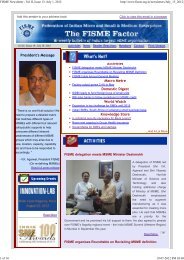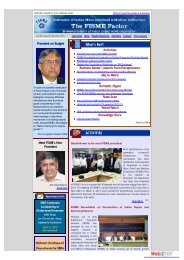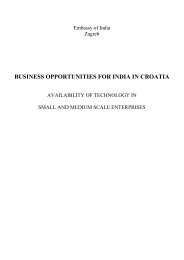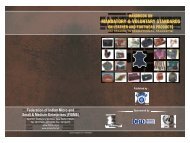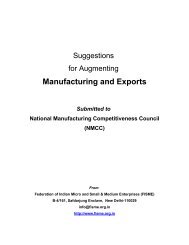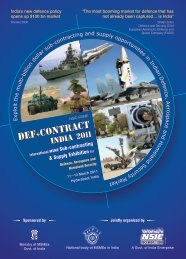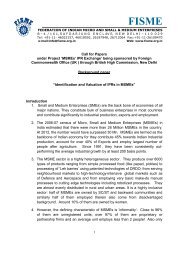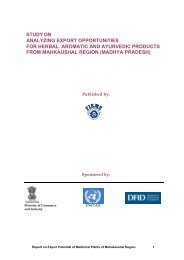SME POLICY SERIES 2 : SME Exchanges in India - Federation of ...
SME POLICY SERIES 2 : SME Exchanges in India - Federation of ...
SME POLICY SERIES 2 : SME Exchanges in India - Federation of ...
You also want an ePaper? Increase the reach of your titles
YUMPU automatically turns print PDFs into web optimized ePapers that Google loves.
FI<strong>SME</strong> <strong>POLICY</strong> PAPER2October 2012<strong>SME</strong><strong>POLICY</strong><strong>SERIES</strong><strong>SME</strong> <strong>Exchanges</strong> <strong>in</strong> <strong>India</strong>: Review and Suggestions*1. BackgroundThe role <strong>of</strong> the capital market <strong>in</strong> growth <strong>of</strong> large companies hardly needs anyelaboration. The case <strong>of</strong> Small and Medium Enterprises (<strong>SME</strong>s) <strong>in</strong> <strong>India</strong>, however, isdifferent. One <strong>of</strong> their characteristic features has been their s<strong>in</strong>gular reliance ondebt f<strong>in</strong>ance that too from conventional sources: Banks, Non-Bank<strong>in</strong>g F<strong>in</strong>anceCompanies (NBFCs) and F<strong>in</strong>ancial Institutions (FIs). Risk capital is largely <strong>in</strong>accessibleto them. Of late, few <strong>SME</strong>s belong<strong>in</strong>g to the services sector and new age technologybased <strong>in</strong>dustries have started gett<strong>in</strong>g access to risk capital through Venture CapitalFunds (VCs) or Private Equity Funds (PEs), but manufactur<strong>in</strong>g <strong>SME</strong>s cont<strong>in</strong>ue tostruggle with drought <strong>of</strong> risk funds as they cannot match the w<strong>in</strong>dfall returns that hightech-servicesector companies can promise.<strong>India</strong> tried to open the risk capital w<strong>in</strong>dow to <strong>SME</strong>s twice <strong>in</strong> past: first with Over-thecounterExchange <strong>of</strong> <strong>India</strong> (OTCEI) launched <strong>in</strong> 1990 and second with 'BSE Indonext'launched <strong>in</strong> 2007. The earlier attempts <strong>in</strong>dicate that retail <strong>in</strong>vestors shied away from<strong>in</strong>vest<strong>in</strong>g <strong>in</strong> <strong>SME</strong>s either because <strong>of</strong> lack <strong>of</strong> knowledge about track record andbus<strong>in</strong>ess models <strong>of</strong> <strong>SME</strong>s or <strong>in</strong>vestor's lack <strong>of</strong> patience <strong>in</strong> understand<strong>in</strong>g nuances <strong>of</strong>the issues and envision<strong>in</strong>g prospects there<strong>of</strong>. It is third time that an attempt has beenmade to create <strong>SME</strong> dedicated platform.2. Policy <strong>in</strong>itiativesIn order to fill this vacuum and based on constant demand from the <strong>SME</strong> sector, SEBI<strong>in</strong>troduced Chapter X-B <strong>in</strong> SEBI (ICDR) Regulations, 2009 (<strong>in</strong>itially <strong>in</strong>troduced asChapter X-A and renumbered through a subsequent amendment) enabl<strong>in</strong>g creation<strong>of</strong> a separate platform for <strong>SME</strong>s desir<strong>in</strong>g access to the capital market. Some <strong>of</strong> the keyfeatures <strong>of</strong> the regulations are:The only way the Smalland Medium enterprisescan access capitalmarket is through<strong>in</strong>tervention byGovernment <strong>of</strong> <strong>India</strong> byway <strong>of</strong> directions to theFIs and the Banks toearmark a smallproportion <strong>of</strong> funds for<strong>in</strong>vest<strong>in</strong>g <strong>in</strong>to the issueson <strong>SME</strong> exchanges.There are regulatory andprocess issues whichcan be sorted outwithout much difficultyonce the BIG decision istaken by theGovernment.a. Transparency <strong>in</strong> report<strong>in</strong>g f<strong>in</strong>ancial and material <strong>in</strong>formation about the issuerCompany and its promoters - detailed requirement <strong>of</strong> the <strong>of</strong>fer document andlist<strong>in</strong>g agreement with the <strong>SME</strong> Exchange <strong>in</strong>sisted upon, on similar l<strong>in</strong>es as forlist<strong>in</strong>g on the Ma<strong>in</strong> Board;b. Increas<strong>in</strong>g the threshold limit <strong>of</strong> <strong>in</strong>vestment to Rs. 1 lakh, thus ensur<strong>in</strong>g thatmarg<strong>in</strong>al <strong>in</strong>vestors do not make <strong>in</strong>vestment <strong>in</strong> <strong>SME</strong>s. The <strong>in</strong>creased <strong>in</strong>vestmentlevel would also ensure that <strong>in</strong>vestors belong<strong>in</strong>g to the HNI category or from the<strong>in</strong>stitutions would participate <strong>in</strong> the <strong>in</strong>vestment <strong>of</strong> <strong>SME</strong>s either <strong>in</strong> the primary orthe secondary market;c. Introduction <strong>of</strong> the concept <strong>of</strong> market mak<strong>in</strong>g for a m<strong>in</strong>imum period <strong>of</strong> 3 yearsto ensure that enough liquidity is ma<strong>in</strong>ta<strong>in</strong>ed <strong>in</strong> the <strong>in</strong>itial period for <strong>in</strong>vestors,exist<strong>in</strong>g or prospective. In a way, it also provides an option for <strong>in</strong>itial <strong>in</strong>vestors toexit from the <strong>in</strong>vestment by sell<strong>in</strong>g shares to the market maker;d. Insistence <strong>of</strong> m<strong>in</strong>imum subscriber level <strong>of</strong> 50 for a successful public issue;e. Increased onus on the Merchant Banker for due diligence and fil<strong>in</strong>g f<strong>in</strong>al* The Policy paper is prepared by FI<strong>SME</strong> team led by Rajesh Dubey, Advisor (F<strong>in</strong>ance) with Jnandeep Saikia,Coord<strong>in</strong>ator (F<strong>in</strong>ance) and Nishita Sharma, Research Intern. The paper is largely based on the proceed<strong>in</strong>gs <strong>of</strong> theStakeholders' Roundtable on <strong>SME</strong> Exchange organized by FI<strong>SME</strong> on 28th March 2012 <strong>in</strong> New Delhi. (See details atback page).1
prospectus or red herr<strong>in</strong>g prospectus with SEBI and Registrar <strong>of</strong> Companiesbefore open<strong>in</strong>g <strong>of</strong> an issue and also provid<strong>in</strong>g market mak<strong>in</strong>g for the sharesfor a period <strong>of</strong> 3 years, either on own accord or through a tie up with anom<strong>in</strong>ated <strong>in</strong>vestor. Also, honor<strong>in</strong>g commitments <strong>of</strong> default<strong>in</strong>g underwriterson devolvement is the responsibility <strong>of</strong> the Merchant Banker;f. 100% underwrit<strong>in</strong>g <strong>of</strong> shares so that the <strong>SME</strong> issuer is ensured <strong>of</strong> success <strong>of</strong> thepublic issue <strong>in</strong> terms <strong>of</strong> rais<strong>in</strong>g capital; andg. Relax<strong>in</strong>g the norm for grad<strong>in</strong>g <strong>of</strong> <strong>in</strong>itial public <strong>of</strong>fer<strong>in</strong>g.In addition to the above, SEBI has issued SEBI (Alternative Investment Fund)Regulations, 2012 which when read together with Sec. 10(23FB) <strong>of</strong> IT Act, 1961,provides for <strong>in</strong>come tax exemption to Venture Capital Fund (VCF) or Venture CapitalCompany (VCC) and Alternative Investment (<strong>SME</strong>) Category I Funds (See Annexure),provided:a) At least 75% <strong>of</strong> their corpus are <strong>in</strong>vested <strong>in</strong> <strong>SME</strong>s or <strong>SME</strong>s listed on <strong>SME</strong>Exchangeb) At least 2/3rd <strong>of</strong> their <strong>in</strong>vestments are <strong>in</strong> unlisted <strong>SME</strong>s or which are listed on the<strong>SME</strong> Exchange and balance <strong>in</strong> other <strong>in</strong>vestments such as shares <strong>of</strong> VentureCapital Undertak<strong>in</strong>gs (VCUs) whose shares are proposed to be listed or suchlisted companies which are f<strong>in</strong>ancially weak or is a sick <strong>in</strong>dustrial undertak<strong>in</strong>g.Additionally, SEBI (Alternative Investment Fund) Regulations, 2012 providesthat Alternative Investment Fund (<strong>SME</strong>) Funds may enter <strong>in</strong>to tie up withMerchant Banker for subscrib<strong>in</strong>g to the unsubscribed portion <strong>of</strong> the sharesissued on <strong>SME</strong> Exchange.From a MerchantBanker's po<strong>in</strong>t <strong>of</strong> view,the market mak<strong>in</strong>g roleentails commitment <strong>of</strong>additionalcapital, requir<strong>in</strong>gadditional fundsarrangement at theirend. Though MerchantBanker can enter <strong>in</strong>toarrangements withnom<strong>in</strong>ated <strong>in</strong>vestors formarket mak<strong>in</strong>g purpose,the onus neverthelessrests with theissuer and MerchantBanker for f<strong>in</strong>d<strong>in</strong>gsuitable <strong>in</strong>vestors withstrong f<strong>in</strong>ancial muscleand as such doesnot seem to be afeasible way out.3. Problems be<strong>in</strong>g encounteredEven with the <strong>in</strong>troduction <strong>of</strong> the regulations for <strong>SME</strong>s list<strong>in</strong>g and <strong>SME</strong> Exchange forover two years, and tax exemption available for <strong>in</strong>vestors, the response to <strong>SME</strong>Exchange has been lackadaisical, ma<strong>in</strong>ly on account <strong>of</strong> the follow<strong>in</strong>g reasons:A. Regulatory requirements which result <strong>in</strong> <strong>in</strong>creas<strong>in</strong>g the capital rais<strong>in</strong>g costmanifoldB. Limited awareness about the changes <strong>in</strong>troduced <strong>in</strong> the SEBI (ICDR)Regulations, 2009 for <strong>SME</strong>s and also limited knowledge about how to go aboutwith an issueC. Nature <strong>of</strong> expectations <strong>of</strong> the <strong>SME</strong> sector with regard to disclosure requirementsassociated with public issue and alternatives available.A. Regulatory requirements which result <strong>in</strong> <strong>in</strong>creas<strong>in</strong>g the capital rais<strong>in</strong>g costCosts associated with any public issue can be clubbed <strong>in</strong> the follow<strong>in</strong>g major heads:Publicity related expenses i.e. mak<strong>in</strong>g the details <strong>of</strong> the public issue known to theprospective <strong>in</strong>vestors; Fees paid to various <strong>in</strong>termediaries associated with the issueand Compliance related expenses for cont<strong>in</strong>u<strong>in</strong>g with list<strong>in</strong>g <strong>of</strong> the issue.From the way the regulations have been drafted and promulgated, it is clear that theauthorities want matured <strong>in</strong>vestors subscrib<strong>in</strong>g to the shares <strong>of</strong> issuer <strong>SME</strong> companieson the <strong>SME</strong> Exchange. Given that, the requirement <strong>of</strong> releas<strong>in</strong>g advertisement <strong>in</strong> atleast one English National Daily, one H<strong>in</strong>di National Daily and a regional languagenewspaper with wide circulation at the place where the registered <strong>of</strong>fice <strong>of</strong> the issuer issituated, at multiple occasions is an avoidable cost for the <strong>SME</strong> units. The times whenadvertisement is required to be released are given below:2a) Pre-issue, after completion <strong>of</strong> due diligence by the Merchant Banker, provid<strong>in</strong>gfor m<strong>in</strong>imum disclosures relat<strong>in</strong>g to the issueb) Information memorandum which would <strong>in</strong>clude snapshot <strong>of</strong> the f<strong>in</strong>ancialstatement
c) Announcement <strong>of</strong> 'issue open<strong>in</strong>g today' on the issue open<strong>in</strong>g dayd) For issues adopt<strong>in</strong>g book build<strong>in</strong>g process - announcement <strong>of</strong> floor price or price band if notmentioned <strong>in</strong> the red herr<strong>in</strong>g prospectus, 2 work<strong>in</strong>g days before open<strong>in</strong>g <strong>of</strong> the bide) Announcement <strong>of</strong> 'issue clos<strong>in</strong>g today' on the issue clos<strong>in</strong>g dayf) Post issue advertisement <strong>in</strong>dicat<strong>in</strong>g details relat<strong>in</strong>g to over subscription, basis <strong>of</strong> allotment, number,value and percentage <strong>of</strong> all applications and successful allottees <strong>in</strong>clud<strong>in</strong>g under ASBA, date <strong>of</strong>completion <strong>of</strong> despatch <strong>of</strong> refund orders or <strong>in</strong>structions to Self-Certified Syndicate Banks by theRegistrar, date <strong>of</strong> despatch <strong>of</strong> certificates and date <strong>of</strong> fil<strong>in</strong>g <strong>of</strong> list<strong>in</strong>g application, etc. is required tobe released with<strong>in</strong> 10 days from the date <strong>of</strong> completion <strong>of</strong> the allotmentAlso, if book - build<strong>in</strong>g process is adopted – revision <strong>in</strong> floor price or price band, if any, has to beannounced by way <strong>of</strong> press releases. Given the size <strong>of</strong> the <strong>SME</strong> issue, the cost <strong>of</strong> releas<strong>in</strong>g advertisementcould be a substantial cost for the <strong>SME</strong>s when compared to the issue size.With regard to fee paid to various <strong>in</strong>termediaries, the most critical responsibility rests on the MerchantBanker viz. due diligence <strong>of</strong> the <strong>of</strong>fer document, market mak<strong>in</strong>g, assessment <strong>of</strong> underwriters' capabilities,tie-up with various other <strong>in</strong>termediaries, underwrit<strong>in</strong>g that portion <strong>of</strong> underwritten shares that anyunderwriter fails to honour etc. <strong>of</strong> the aforementioned roles, the role for market mak<strong>in</strong>g and honour<strong>in</strong>gcommitments <strong>of</strong> underwriters who fail to subscribe their portion on devolvement are additionalresponsibilities when compared to responsibilities on the Ma<strong>in</strong> Board. It is natural to expect that theMerchant Banker would ask additional fee for the additional services <strong>of</strong>fered by them which would be anadditional cost for the <strong>SME</strong>s issu<strong>in</strong>g shares on the <strong>SME</strong> Exchange.From a Merchant Banker's po<strong>in</strong>t <strong>of</strong> view, the market mak<strong>in</strong>g role entails commitment <strong>of</strong> additionalcapital, requir<strong>in</strong>g additional funds arrangement at their end. Though Merchant Banker can enter <strong>in</strong>toarrangements with nom<strong>in</strong>ated <strong>in</strong>vestors for market mak<strong>in</strong>g purpose, the onus nevertheless rests with theissuer and Merchant Banker for f<strong>in</strong>d<strong>in</strong>g suitable <strong>in</strong>vestors with strong f<strong>in</strong>ancial muscle and as such doesnot seem to be a feasible way out.Alternatively, if l<strong>in</strong>e <strong>of</strong> credit support is obta<strong>in</strong>ed by the Merchant Banker, it effectively would mean us<strong>in</strong>gborrowed capital for an activity for which the required amount for market mak<strong>in</strong>g by the MerchantBanker may get blocked for a substantially longer tenure than when compared to tenure <strong>of</strong> the l<strong>in</strong>e <strong>of</strong>credit obta<strong>in</strong>ed. This would result <strong>in</strong>to an asset liability maturity mismatch and also a funds flowmismatch. The capital base <strong>of</strong> most <strong>of</strong> the Merchant Bankers is not strong enough to absorb this risk ontheir own account. The only option left to them is to transfer the risk on a back-to-back arrangement(<strong>of</strong>ten through an <strong>of</strong>fl<strong>in</strong>e contract) with the promoters <strong>of</strong> the issuer Company, nullify<strong>in</strong>g the very purpose<strong>of</strong> approach<strong>in</strong>g <strong>SME</strong> Exchange. Such transactions will rema<strong>in</strong> hidden and unaccounted push<strong>in</strong>g theentrepreneur more <strong>in</strong> risk rather provid<strong>in</strong>g risk capital to <strong>SME</strong>. The above could be considered as one <strong>of</strong>the ma<strong>in</strong> reasons for not many <strong>SME</strong>s and Merchant Bankers com<strong>in</strong>g forward with public issues on the<strong>SME</strong> Exchange.B. Limited Awareness on list<strong>in</strong>g on <strong>SME</strong> ExchangeThe awareness about separate platform for <strong>SME</strong> list<strong>in</strong>gs on <strong>SME</strong> Exchange is not well spread amongst<strong>SME</strong>s. Also the awareness, if existent, is limited to a prelim<strong>in</strong>ary awareness that a new option is availablefor <strong>SME</strong>s to raise capital. However, the way to go about it <strong>in</strong> terms <strong>of</strong> - the procedure <strong>in</strong>volved, parties tobe engaged, eligibility norms etc. is not known to a majority <strong>of</strong> <strong>SME</strong>s.C. Expectations <strong>of</strong> the <strong>SME</strong> sector towards disclosure requirements and available alternativesfor rais<strong>in</strong>g risk capitalFor <strong>SME</strong>s belong<strong>in</strong>g to the services sector or <strong>in</strong> the technology space, where escalated growth rate andhigh returns on capital are possible, the alternative <strong>of</strong> rais<strong>in</strong>g capital from VCFs and PEs are moreattractive on a private placement basis than opt<strong>in</strong>g for the <strong>SME</strong> Exchange route <strong>of</strong> list<strong>in</strong>g <strong>of</strong> IPOs. Thema<strong>in</strong> reasons why <strong>SME</strong>s f<strong>in</strong>d private placement to VCFs and PEs more attractive are –a) Additional disclosure requirements for the IPO which would have to be made available <strong>in</strong> publicdoma<strong>in</strong>; the same may not be contemplated <strong>in</strong> the best <strong>in</strong>terest for the <strong>SME</strong> unit.3
) Forecasts are more futuristic <strong>in</strong> nature which may be frowned upon at the time<strong>of</strong> due diligence by the Merchant Banker.c) Satisfy<strong>in</strong>g the <strong>in</strong>formation and disclosure requirements for m<strong>in</strong>imum 50<strong>in</strong>vestors post issue may be more cumbersome for an issuer Company thansatisfy<strong>in</strong>g a few VCFs and PEs on the Board.d) Also the VCFs and PE <strong>in</strong>vestors are likely to br<strong>in</strong>g <strong>in</strong> more doma<strong>in</strong> expertise <strong>in</strong>their association with the issuer Company than the passive <strong>in</strong>vestors throughthe IPO route.The above mentioned po<strong>in</strong>ts may be true for service enterprises or new agetechnology oriented <strong>SME</strong>s where VCF and PE options are available to the deserv<strong>in</strong>gentities with a good <strong>in</strong>vestment and bus<strong>in</strong>ess plans, the same may not be true for theconventional manufactur<strong>in</strong>g <strong>in</strong>dustry. The VCFs and PEs may not be <strong>in</strong>terested <strong>in</strong><strong>in</strong>vest<strong>in</strong>g <strong>in</strong> conventional <strong>in</strong>dustry provid<strong>in</strong>g modest returns with reasonableconsistency.For <strong>SME</strong> units belong<strong>in</strong>g to the conventional manufactur<strong>in</strong>g sector, the apprehension<strong>of</strong> use <strong>of</strong> pr<strong>of</strong>itability figures if available <strong>in</strong> public doma<strong>in</strong> by vendors and suppliers forhard negotiations on pric<strong>in</strong>g is real and immediate as <strong>SME</strong> units would be expected todisclose <strong>in</strong> greater details and half-yearly periodicity, on their performance. On theother hand, unlisted public limited Companies may have to disclose pr<strong>of</strong>itabilityfigures once a year and the <strong>in</strong>formation is available through Registrar <strong>of</strong> Companies.To a certa<strong>in</strong> extent it is not so easily available <strong>in</strong> public doma<strong>in</strong>. Thus, access<strong>in</strong>gcapital market through list<strong>in</strong>g on <strong>SME</strong> exchange and adher<strong>in</strong>g to greater disclosurerequirements would have to be a reasonably balanced decision for an <strong>SME</strong>.Success <strong>of</strong> this renewedattempt by theGovernment <strong>of</strong> <strong>India</strong>(with necessary supportfrom the regulator) forencourag<strong>in</strong>g sett<strong>in</strong>g up<strong>of</strong> <strong>SME</strong> exchanges istherefore crucial if thesmaller companies areever able to drawsupport from the capitalmarkets. The <strong>SME</strong>exchanges have to notonly take <strong>of</strong>f but alsorema<strong>in</strong> active andbuoyant for quite sometime. This can happenonly if the <strong>in</strong>stitutional<strong>in</strong>vestors agree toparticipate <strong>in</strong> <strong>SME</strong>exchanges until the retail<strong>in</strong>vestors enter the fieldand the exchangeacquires a critical mass.Because the size willgrow only gradually evena m<strong>in</strong>iscule share <strong>of</strong> their<strong>in</strong>vestible funds cansusta<strong>in</strong> the exchanges.Success <strong>of</strong> this renewed attempt by the Government <strong>of</strong> <strong>India</strong> (with necessary supportfrom the regulator) for encourag<strong>in</strong>g sett<strong>in</strong>g up <strong>of</strong> <strong>SME</strong> exchanges is therefore crucial ifthe smaller companies are ever able to draw support from the capital markets. The<strong>SME</strong> exchanges have to not only take <strong>of</strong>f but also rema<strong>in</strong> active and buoyant for quitesome time. This can happen only if the <strong>in</strong>stitutional <strong>in</strong>vestors agree to participate <strong>in</strong><strong>SME</strong> exchanges until the retail <strong>in</strong>vestors enter the field and the exchange acquires acritical mass. Because the size will grow only gradually even a m<strong>in</strong>iscule share <strong>of</strong> their<strong>in</strong>vestible funds can susta<strong>in</strong> the exchanges.4. Suggestions:[FI<strong>SME</strong> carried out a series <strong>of</strong> discussions with M<strong>SME</strong>s, Banks and FIs, <strong>SME</strong> <strong>Exchanges</strong>,Merchant Bankers, VCs, PEs, economists, f<strong>in</strong>ancials experts and senior government<strong>of</strong>ficials at New Delhi, Bangalore and Mumbai and the concerns <strong>of</strong> stakeholderswere f<strong>in</strong>ally discussed dur<strong>in</strong>g a Stakeholders' Roundtable on <strong>SME</strong> Exchange' organizedon 28th March 2012 <strong>in</strong> New Delhi. The suggestions emerged dur<strong>in</strong>g the roundtableare summarized thus. ]41. The unanimous conclusion <strong>of</strong> the <strong>in</strong>tensive consultative process has been: Theonly way <strong>SME</strong>s can access capital market is through <strong>in</strong>tervention byGovernment <strong>of</strong> <strong>India</strong> by way <strong>of</strong> directions to the FIs and the Banks to earmark asmall proportion <strong>of</strong> funds for <strong>in</strong>vest<strong>in</strong>g <strong>in</strong>to the issues on <strong>SME</strong> exchanges.There are regulatory and process issues which can be sorted out without muchdifficulty once the BIG decision is taken by the Government.[M<strong>in</strong>istry <strong>of</strong> F<strong>in</strong>ance may take required steps]2. To reduce this cost, it is proposed that it should be sufficient for the issuer torelease <strong>in</strong>formation through the website <strong>of</strong> SEBI, Merchant Banker, <strong>SME</strong>Exchange and its own website and also as part <strong>of</strong> important recordannouncements (as for announcement <strong>of</strong> Board Meet<strong>in</strong>g, Book closure datesand record dates) <strong>in</strong> lead<strong>in</strong>g f<strong>in</strong>ancial and national dailies. The same would <strong>in</strong>
any case be noticed by the targeted subscribers for the <strong>SME</strong> issues viz., <strong>in</strong>stitutions and HNIs. Theissuance <strong>of</strong> detailed advertisement by <strong>SME</strong>s may be made optional <strong>in</strong> place <strong>of</strong> mandatory as <strong>of</strong>now.[SEBI may suitably amend SEBI (ICDR) Regulations, 2009].3. To address the issue <strong>of</strong> market mak<strong>in</strong>g, a few structural changes suggested are:a) Onus on market mak<strong>in</strong>g should not rest with Merchant Bankers. They should cont<strong>in</strong>ue undertak<strong>in</strong>gthe other fee based activity where they have a normal specialization.[SEBI may suitably amend SEBI (ICDR) Regulations, 2009].b) Onus <strong>of</strong> market mak<strong>in</strong>g should be on banks, <strong>in</strong>surance companies and f<strong>in</strong>ancial <strong>in</strong>stitutions,hav<strong>in</strong>g large capital and assets base. A small portion <strong>of</strong> their portfolio cold be earmarked for<strong>in</strong>vestment <strong>in</strong> equity shares or specified securities issued and traded on <strong>SME</strong> <strong>Exchanges</strong>, say:1- For banks - 5% <strong>of</strong> the total <strong>in</strong>vestment portfolio <strong>in</strong> capital market or 1% - 3% <strong>of</strong> the net-worth(<strong>in</strong>creas<strong>in</strong>g annually by 1% po<strong>in</strong>t), whichever is lower. Investments made by banks <strong>in</strong> issueslisted on <strong>SME</strong> Exchange should be excluded rom the capital market exposure norms, providedthey are undertaken as part <strong>of</strong> market mak<strong>in</strong>g exercise.[RBI may issue suitable guidel<strong>in</strong>es <strong>in</strong>clud<strong>in</strong>g amendment tothe guidel<strong>in</strong>es on the Capital Market Exposure Norms].- For <strong>in</strong>surance companies – 1% <strong>of</strong> Assets under management.[M<strong>in</strong>istry <strong>of</strong> F<strong>in</strong>ance, GOI to advise <strong>in</strong>surance companies / IRDA suitably].c) Additionally, <strong>in</strong>vestment <strong>in</strong> <strong>SME</strong> equity as part <strong>of</strong> <strong>in</strong>itial subscription or underwrit<strong>in</strong>g commitmentsor for market mak<strong>in</strong>g purpose as a market maker or as a nom<strong>in</strong>ated <strong>in</strong>vestor should qualify aspriority sector lend<strong>in</strong>g. Banks may be asked to provide for market mak<strong>in</strong>g <strong>in</strong> respect <strong>of</strong> at least 10<strong>SME</strong>s per bank <strong>in</strong> a year. To beg<strong>in</strong> with this target could be achieved over 2 – 3 years given thenascent nature <strong>of</strong> <strong>SME</strong> Exchange. However, if accepted, the banks could be asked to at least makea beg<strong>in</strong>n<strong>in</strong>g <strong>in</strong> the current f<strong>in</strong>ancial year. It may be mentioned here that banks are ideally suited forprovid<strong>in</strong>g market mak<strong>in</strong>g and for tak<strong>in</strong>g an equity position <strong>in</strong> <strong>SME</strong>s. By the very nature <strong>of</strong> work<strong>in</strong>gcapital provided <strong>in</strong> the form <strong>of</strong> cash credit, the exposure is normally <strong>of</strong> a very long duration even ifreviewed and renewed on an annual basis. As such, dur<strong>in</strong>g grow<strong>in</strong>g stage and upside sw<strong>in</strong>g for an<strong>SME</strong>s, the performance <strong>of</strong> <strong>SME</strong>s are normally better, command<strong>in</strong>g better lend<strong>in</strong>g terms frombanks. Conversely, dur<strong>in</strong>g decl<strong>in</strong><strong>in</strong>g stage <strong>in</strong> the <strong>in</strong>dustry, when the performance <strong>of</strong> the <strong>SME</strong>s is ona decl<strong>in</strong>e, the <strong>SME</strong>s f<strong>in</strong>d it difficult to service high cost <strong>of</strong> borrow<strong>in</strong>gs.More <strong>of</strong>ten than not, banks are required to agree for reduction <strong>in</strong> <strong>in</strong>terest rates <strong>in</strong> case anyrestructur<strong>in</strong>g exercise is undertaken. Thus, though the assistance is given <strong>in</strong> the form <strong>of</strong> loans, it haspeculiar characteristics <strong>of</strong> risk capital except that banks cannot command higher returns <strong>in</strong> theevent <strong>of</strong> upside <strong>in</strong> the bus<strong>in</strong>ess <strong>of</strong> an <strong>SME</strong>.Given this backdrop, it would be beneficial for a Bank to grant assistance to <strong>SME</strong>s as acomb<strong>in</strong>ation <strong>of</strong> debt and equity, especially where they have had a good track record for pastassistance granted. The limits here<strong>in</strong>above suggested would enable banks identify good <strong>SME</strong>s <strong>in</strong>their portfolio and encourage them towards access<strong>in</strong>g capital market.[RBI to suitably modify the priority sector lend<strong>in</strong>g norms].d) RBI may frame guidel<strong>in</strong>es to address the Banks' concern mak<strong>in</strong>g <strong>in</strong>vestment <strong>in</strong> the unlisted shares<strong>of</strong> <strong>SME</strong>s to avoid such <strong>in</strong>vestments be<strong>in</strong>g construed as 'ever-green<strong>in</strong>g' especially if the <strong>SME</strong>s arerated <strong>in</strong> the top 3 on the <strong>in</strong>ternal rat<strong>in</strong>g scale <strong>of</strong> the Bank concerned or <strong>in</strong> the top 3 <strong>of</strong> the scale <strong>of</strong> theexternal credit rat<strong>in</strong>g agency.[RBI to suitably advise].1The prudential norms for banks limit capital market exposures to 20% <strong>of</strong> the Bank's Networth on a solo basis and 40% <strong>of</strong> the consolidatedNetworth on a consolidated basis (consolidated Bank would <strong>in</strong>clude licensed banks along with its subsidiaries).5
e) Market makers could issue advertisements to popularize the <strong>SME</strong>s <strong>in</strong> which theyhave <strong>in</strong>vested by provid<strong>in</strong>g <strong>in</strong>formation on f<strong>in</strong>ancial performance and therebycreate a market for prospective <strong>in</strong>vestors. Market mak<strong>in</strong>g can be provided tillsuch period where the shares cont<strong>in</strong>ue to rema<strong>in</strong> frequently traded for am<strong>in</strong>imum period <strong>of</strong> 1 year and till such time where banks <strong>in</strong>vestment doesn'tfall below 10% or for 3 years, which is earlier.[Market makers to take <strong>in</strong>itiative].f) The requirement <strong>of</strong> m<strong>in</strong>imum 50 <strong>in</strong>vestors at the time <strong>of</strong> issue should be doneaway with, as it is expected that only <strong>in</strong>stitutional <strong>in</strong>vestors would be <strong>in</strong>terested<strong>in</strong> <strong>in</strong>vest<strong>in</strong>g <strong>in</strong> <strong>SME</strong>s <strong>in</strong> the <strong>in</strong>itial stages.[SEBI may suitably amend SEBI (ICDR) Regulations, 2009].g) After list<strong>in</strong>g, more <strong>in</strong>vestors can f<strong>in</strong>d the <strong>SME</strong> scrip attractive if the lot size can bereduced from the exist<strong>in</strong>g lot size which is <strong>of</strong> a m<strong>in</strong>imum value <strong>of</strong> Rs. 1 lakh atthe time <strong>of</strong> list<strong>in</strong>g.[SEBI may suitably amend SEBI (ICDR) Regulations, 2009].h) Grad<strong>in</strong>g for <strong>SME</strong> IPOs should be made mandatory. However, a separate gradescale should be adopted for the <strong>SME</strong> issues so that well perform<strong>in</strong>g <strong>SME</strong>s orventures with great bus<strong>in</strong>ess ideas get a chance <strong>of</strong> gett<strong>in</strong>g the best grad<strong>in</strong>gfrom the Credit Rat<strong>in</strong>g Agencies.[SEBI may suitably amend SEBI (ICDR) Regulations, 2009].i) Income tax exemption is presently available to Venture Capital Funds andAlternative Investment (<strong>SME</strong>) Funds hav<strong>in</strong>g corpus <strong>in</strong>vested <strong>in</strong> <strong>SME</strong>s <strong>in</strong> excess <strong>of</strong>75%. It is suggested that <strong>in</strong>come accru<strong>in</strong>g to any registered fund or <strong>in</strong>vestorwith SEBI <strong>in</strong>clud<strong>in</strong>g non-<strong>SME</strong> Alternative Investment Funds <strong>in</strong>vest<strong>in</strong>g <strong>in</strong> <strong>SME</strong>s,out <strong>of</strong> such <strong>in</strong>vestments should be exempted from the provisions <strong>of</strong> <strong>in</strong>come tax.The suggestion is made to enlarge the avenues <strong>of</strong> equity capital availability to<strong>SME</strong>s, from whatever source that may be available.[M<strong>in</strong>istry <strong>of</strong> F<strong>in</strong>ance, GOI may carry-out the required amendment].4. It is expedient to popularize the same by conven<strong>in</strong>g sem<strong>in</strong>ars and workshops onthe subject <strong>in</strong>volv<strong>in</strong>g all the major participants. The Investor Protection &Education Fund set up under SEBI Regulations for the Fund <strong>in</strong> 2009 may be usedfor such <strong>in</strong>vestor and issuer workshops. If need be, MoM<strong>SME</strong> could also berequested for mak<strong>in</strong>g allocations for <strong>in</strong>vestor and <strong>SME</strong> education. <strong>SME</strong>associations could be associated <strong>in</strong> populariz<strong>in</strong>g the events and educat<strong>in</strong>g <strong>SME</strong>son the procedural requirements and economical advantage from rais<strong>in</strong>g capitalresources through public issue on <strong>SME</strong> Exchange. Programs and workshops couldbe organized <strong>in</strong> all the major clusters with the top 50 clusters gett<strong>in</strong>g covered <strong>in</strong> thefirst year. The feedback from the <strong>SME</strong> stakeholders and prospective retail /<strong>in</strong>stitutional <strong>in</strong>vestors could also be used <strong>in</strong> mak<strong>in</strong>g amendments to theregulations, where necessary.[SEBI, M<strong>in</strong>istry <strong>of</strong> M<strong>SME</strong>, Stock <strong>Exchanges</strong>, Merchant Bankers,FI<strong>SME</strong> and other associations and pr<strong>of</strong>essional bodies].5. The disclosure requirements can be restricted for provid<strong>in</strong>g only limited<strong>in</strong>formation about the issuer Company's performance could be considered, ifsome <strong>of</strong> the earlier suggestions are accepted, viz.:a) Mandatory grad<strong>in</strong>g <strong>of</strong> IPOs with annual or semi-annual surveillance exerciseby Credit Rat<strong>in</strong>g Agenciesb) Institutional <strong>in</strong>vestors and banks market mak<strong>in</strong>g <strong>in</strong> the <strong>in</strong>itial period wouldprovide greater confidence to the retail <strong>in</strong>vestors.[SEBI may suitably amend SEBI (ICDR) Regulations, 2009]6
AnnexureTax benefits to VCF / VCC and Alternative Investment (<strong>SME</strong>) Funds – Category-I aris<strong>in</strong>g out <strong>of</strong> Sec. 10(23FB) <strong>of</strong> Income TaxAct, 1961 read with SEBI (Alternative Investment Funds) Regulations, 2012Any <strong>in</strong>come <strong>of</strong> a Venture Capital Company (VCC) or Venture Capital Fund (VCF) from <strong>in</strong>vestment <strong>in</strong> a Venture Capital Undertak<strong>in</strong>g(VCU) is exempt from <strong>in</strong>come tax. Eligible VCC, VCF and VCU are def<strong>in</strong>ed <strong>in</strong> SEBI (Venture Capital Fund) Regulations, 1996, whichhave s<strong>in</strong>ce been resc<strong>in</strong>ded after notification <strong>of</strong> SEBI (Alternative Investment Funds) Regulations, 2012. VCU are entities which are notlisted and which do not fall <strong>in</strong> the negative list <strong>of</strong> SEBI and GOI. With SEBI (Alternative Investment Funds) Regulations, 2012, the scope<strong>of</strong> <strong>in</strong>come tax benefits have been enlarged to <strong>in</strong>clude Alternative Investment Funds registered as Category I <strong>SME</strong> funds (i.e. where<strong>in</strong>vestments made <strong>in</strong> <strong>SME</strong>s as def<strong>in</strong>ed under M<strong>SME</strong> Development Act, 2006, exceeds 75% <strong>of</strong> the fund size) by <strong>in</strong>clud<strong>in</strong>g such fundswith<strong>in</strong> the mean<strong>in</strong>g <strong>of</strong> VCF or VCC eligible for exemption under Sec. 10(23FB) <strong>of</strong> the IT Act, 1961.Excerpts <strong>of</strong> law relat<strong>in</strong>g to Securities Transaction Tax - Even <strong>in</strong>come aris<strong>in</strong>g out <strong>of</strong> divestment on <strong>in</strong>itial public <strong>of</strong>fer made by any<strong>in</strong>vestor (<strong>in</strong>clud<strong>in</strong>g <strong>of</strong>fers made by VCC or VCF) is exempt from tax if the <strong>in</strong>come is <strong>in</strong> the nature <strong>of</strong> long term capital ga<strong>in</strong>s providedSecurities Transaction Tax (STT) has been paid at 0.2%. If the ga<strong>in</strong> is <strong>in</strong> the nature <strong>of</strong> short term, on payment <strong>of</strong> STT @ 0.2%, theapplicable tax on the short term capital ga<strong>in</strong> would be flat 10%. The <strong>in</strong>come has to arise <strong>of</strong> <strong>in</strong>vestment transactions. In other words,<strong>in</strong>come <strong>in</strong> nature <strong>of</strong> dividend on equity <strong>of</strong> preference shares, short term or long term capital ga<strong>in</strong>s, are exempt from payment <strong>of</strong><strong>in</strong>come tax under Sec. 10(23FB) <strong>of</strong> IT Act, 1961. Any other <strong>in</strong>come or ga<strong>in</strong> <strong>in</strong> the nature <strong>of</strong> fees, royalties, etc. would be exempt from ITAct, 1961, provided the same is aris<strong>in</strong>g <strong>of</strong> the <strong>in</strong>vestment covenants <strong>of</strong> the VCC or VCF <strong>in</strong> the VCU.SEBI (Venture Capital Funds) Regulations, 1996 (s<strong>in</strong>ce resc<strong>in</strong>ded but exist<strong>in</strong>g VCF would cont<strong>in</strong>ue to be governed under theregulation ill the closure <strong>of</strong> the VCF; no additional funds can be raised or scheme launched under except under SEBI (AlternativeInvestment Funds) Regulations, 2012)Sec 2(n) def<strong>in</strong>e “venture capital undertak<strong>in</strong>g” as a domestic company—(i) whose shares are not listed on a recognized stock exchange <strong>in</strong> <strong>India</strong>;(ii) which is engaged <strong>in</strong> the bus<strong>in</strong>ess for provid<strong>in</strong>g services, production or manufacture <strong>of</strong> article or th<strong>in</strong>gs or does not <strong>in</strong>cludesuch activities or sectors which are specified <strong>in</strong> the negative list by the Board with the approval <strong>of</strong> the Central Government bynotification <strong>in</strong> the Official Gazette <strong>in</strong> this behalf.SEBI (Alternative Investment Funds) Regulations, 2012 - Def<strong>in</strong>itionsSec. 2(1)(o) def<strong>in</strong>es “<strong>in</strong>vestee company” as any company, special purpose vehicle or limited liability partnership or body corporate<strong>in</strong> which an Alternative Investment Fund makes an <strong>in</strong>vestment;Sec. 2(1)(s) def<strong>in</strong>es “<strong>SME</strong>” as Small and Medium Enterprise and shall have the same mean<strong>in</strong>g as assigned to it under the Micro,Small and Medium Enterprises Development Act 2006 as amended from time to time;Sec. 2(1)(t) def<strong>in</strong>es “<strong>SME</strong> fund” means an Alternative Investment Fund which <strong>in</strong>vests primarily <strong>in</strong> unlisted securities <strong>of</strong> <strong>in</strong>vesteecompanies which are <strong>SME</strong>s or securities <strong>of</strong> those <strong>SME</strong>s which are listed or proposed to be listed on a <strong>SME</strong> exchange or <strong>SME</strong> segment <strong>of</strong>an exchange;Sec. 2(1)(z) def<strong>in</strong>es “venture capital fund” means an Alternative Investment Fund which <strong>in</strong>vests primarily <strong>in</strong> unlisted securities <strong>of</strong>start-ups, emerg<strong>in</strong>g or early-stage venture capital undertak<strong>in</strong>gs ma<strong>in</strong>ly <strong>in</strong>volved <strong>in</strong> new products, new services, technology or<strong>in</strong>tellectual property right based activities or a new bus<strong>in</strong>ess model;Sec. 2(1)(aa) def<strong>in</strong>es “venture capital undertak<strong>in</strong>g” means a domestic company:(i) which is not listed on a recognised stock exchange <strong>in</strong> <strong>India</strong> at the time <strong>of</strong> mak<strong>in</strong>g <strong>in</strong>vestment; and(ii) which is engaged <strong>in</strong> the bus<strong>in</strong>ess for provid<strong>in</strong>g services, production or manufacture <strong>of</strong> article or th<strong>in</strong>gs and does not <strong>in</strong>cludefollow<strong>in</strong>g activities or sectors:(1) non-bank<strong>in</strong>g f<strong>in</strong>ancial companies;(2) gold f<strong>in</strong>anc<strong>in</strong>g;(3) activities not permitted under <strong>in</strong>dustrial policy <strong>of</strong> Government <strong>of</strong> <strong>India</strong>;(4) any other activity which may be specified by the Board <strong>in</strong> consultation with Government <strong>of</strong> <strong>India</strong> from time to time;Sec. 3(4) Alternative Investment Funds shall seek registration <strong>in</strong> one <strong>of</strong> the categories mentioned hereunder and <strong>in</strong> case <strong>of</strong>Category I Alternative Investment Fund, <strong>in</strong> one <strong>of</strong> the subcategories there<strong>of</strong>:(a) “Category I Alternative Investment Fund” which <strong>in</strong>vests <strong>in</strong> start-up or early stage ventures or social ventures or <strong>SME</strong>s or<strong>in</strong>frastructure or other sectors or areas which the government or regulators consider as socially or economically desirable andshall <strong>in</strong>clude venture capital funds, <strong>SME</strong> Funds, social venture funds, <strong>in</strong>frastructure funds and such other AlternativeInvestment Funds as may be specified;Explanation ─ For the purpose <strong>of</strong> this clause, Alternative Investment Funds which are generally perceived to have positive spillovereffects on economy and for which the Board or Government <strong>of</strong> <strong>India</strong> or other regulators <strong>in</strong> <strong>India</strong> might consider provid<strong>in</strong>g<strong>in</strong>centives or concessions shall be <strong>in</strong>cluded and such funds which are formed as trusts or companies shall be construed as “venturecapital company” or “venture capitalfund” as specified under sub-section (23FB) <strong>of</strong> Section 10 <strong>of</strong> the Income Tax Act, 1961.Securities transaction Tax (STT) is a tax be<strong>in</strong>g levied on all transactions done on the stock exchanges. Securities Transaction Tax isapplicable on purchase or sale <strong>of</strong> equity shares, derivatives, equity oriented funds and equity oriented Mutual Funds. In other words,the same is not applicable on preference shares or debentures or any other securities other than equity. Current STT on purchase orsell <strong>of</strong> an equity share is 0.075%. If STT has been paid at the time <strong>of</strong> sell<strong>in</strong>g securities (shares), the law relat<strong>in</strong>g to Income Tax is:FOR INVESTORS -(1) Shares are sold after 12 months, it comes under long term capital ga<strong>in</strong>s no tax ispayable on that ga<strong>in</strong>.(2) Shares are sold before 12 months, it is a short term capital ga<strong>in</strong>s and Income Tax @10% flat is payable on the ga<strong>in</strong>.FOR TRADERS –All ga<strong>in</strong>s are treated as trad<strong>in</strong>g (Bus<strong>in</strong>ess) and tax is payable as per appropriate tax slabs. However, STT paid on transactions can beclaimed as a deductible expense.STT on IPO and benefits <strong>in</strong> payment <strong>of</strong> Income Tax :Benefit <strong>of</strong> capital ga<strong>in</strong>s tax exemption has been extended to sale <strong>of</strong> unlisted securities <strong>in</strong> an <strong>in</strong>itial public <strong>of</strong>fer<strong>in</strong>g. However, a securitiestransaction tax at the rate <strong>of</strong> 0.2 % will be payable on such a transaction.7
Stakeholders’ Roundtable on <strong>SME</strong> Exchangeth(28 March 2012, <strong>India</strong> Habitat Center, New Delhi)ParticipantsMr. Lakshman Gugulothu, IPS, CEO - <strong>SME</strong> Exchange, Bombay Stock Exchange (BSE), MumbaiMr. Ananta Padmanabhan Sarma, CEO, SIDBI Venture Capital Ltd, MumbaiMr. Ravi Tyagi, <strong>SME</strong> Exchange Project, NSE, MumbaiMr. Anurag Goyal, Vice President, Microsec Capital Ltd, New DelhiPr<strong>of</strong>. Sanjay Sehgal, Dean - Faculty <strong>of</strong> Commerce and Bus<strong>in</strong>ess, Delhi UniversityPr<strong>of</strong>. Muneesh Kumar, Head - International Relations, Delhi UniversityMr. Kulbhushan Parashar, Director RSJ Capital Ventures Pvt. Ltd, New DelhiMr. S P Gupta Director TSP Management & F<strong>in</strong>ancial Advisors (P) Ltd.Mr. Mun<strong>in</strong>dra Sehgal, Associate - Mergers, Acquisition & Restructur<strong>in</strong>g Div, JM F<strong>in</strong>ancial ConsultantsMr. Rajesh Dubey, Former ED-<strong>SME</strong>, ICRA, Advisor (F<strong>in</strong>ance), FI<strong>SME</strong>Mr. V.K. Agarwal, President FI<strong>SME</strong> & MD, Shashi Cables Ltd, LucknowMr. D. Gandhikumar, Gandhikumar Foundry, CoimbatoreMr. Arjun Navada, MD, Eastern Switchgear & Electrical Company Pvt. Ltd., KolkataMr. R. Sada Siva Reddy, President, Jeedimetla Industries Association, HyderbadMr. Deepak Ja<strong>in</strong>, Manag<strong>in</strong>g Director, Bhansali Cables & Conductors Private Ltd, New DelhiMr. C.S. Goel, Manag<strong>in</strong>g Director, Goel Eng<strong>in</strong>eers (<strong>India</strong>), New DelhiMr. Naveen Ja<strong>in</strong>, MD, Dayachand Engg. Industries Pvt. Ltd., MuzaffarnagarMr. D<strong>in</strong>esh S<strong>in</strong>ghal, MD, Kanohar Electricals Ltd, MeerutMr. Neeraj Kedia, MD, Chakradhar Chemicals Pvt. Ltd., MuzaffarnagarMr. Pankaj Aggarwal, Manag<strong>in</strong>g Director, B<strong>in</strong>dlas Duplux Ltd., MuzaffarnagarMr. Anil Bhardwaj, Secretary General, FI<strong>SME</strong>, New Delhi<strong>Federation</strong> <strong>of</strong> <strong>India</strong>n Micro Small & Medium Enterprises (FI<strong>SME</strong>)FI<strong>SME</strong> came <strong>in</strong>to be<strong>in</strong>g <strong>in</strong> 1995 as a federation <strong>of</strong> geographical and sectoral associations <strong>of</strong> Micro, Smalland Medium Enterprises (M<strong>SME</strong>s) spread across districts and states <strong>in</strong> <strong>India</strong>. Born dur<strong>in</strong>g period <strong>of</strong>liberalization and at the time <strong>of</strong> <strong>India</strong>’s accession to WTO, its m<strong>in</strong>dset, mission and activities have beenshaped by these national and global developments. It is a multi-sector, politically neutral and not-forpr<strong>of</strong>itorganization. It aims to facilitate development <strong>of</strong> an entrepreneurial and competitive environmentat home and greater market access for <strong>India</strong>n M<strong>SME</strong>s <strong>in</strong> <strong>India</strong> and abroad. Work<strong>in</strong>g with a strongorientation for reforms <strong>in</strong> regulatory environment and public promotional policies to enhancecompetitiveness <strong>of</strong> M<strong>SME</strong>s vis-à-vis their larger domestic counterparts and foreign firms, FI<strong>SME</strong> organizesa wide range <strong>of</strong> M<strong>SME</strong> support programmes and undertakes implementation <strong>of</strong> developmental projects.It is widely regarded as the progressive face <strong>of</strong> <strong>India</strong>n M<strong>SME</strong>s.[For more details: http://www.fisme.org.<strong>in</strong>]<strong>Federation</strong> <strong>of</strong> <strong>India</strong>n Micro and Small & Medium Enterprises (FI<strong>SME</strong>)B - 4 / 161, Safdarjung Enclave, New Delhi-110029 INDIATelephone : +91-11- 26187948, 26712064, 46023157, 46018592 Fax : +91-11- 26109470 Email : <strong>in</strong>fo@fisme.org.<strong>in</strong>



